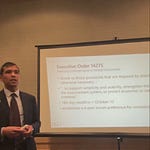One of the questions I’ve received is: What is the role of OSDBU under the FAR Overhaul, and how will the companion guide affect the roles of the OSDBU?
It seems as if the roles of the OSDBU were minimized. I think that’s absolutely right. The roles of the OSDBU have been minimized in the FAR Overhaul, but I’m not sure it’s going to matter.
What the FAR Overhaul did is take all the content of the responsibilities of the OSDBU and, in the FAR Overhaul, delete them. Potentially they will come back in the FAR companion guide. All those responsibilities of the OSDBU are statutory—they’re in Part 15(k) of the Small Business Act. About 21 responsibilities altogether. They include supervision, appointing small business technical advisors, things like helping with the SBIR program, and helping small business subcontractors get paid. So there are very important responsibilities for the OSDBU. Small businesses rely on the OSDBU to perform these responsibilities.
Those responsibilities are not going away. They’re still in the Small Business Act. They’re still in Section 15(k). They’re not in the FAR Overhaul, but the FAR Overhaul can’t override a statute. So 15(k) is still in effect.
The FAR Overhaul effort was to try to minimize the number of words in the FAR and really keep it to things that were relevant to contracting officers. And it’s not really necessary that contracting officers know what the responsibilities of OSDBU are. I think that was the logic behind deleting that material from the FAR Overhaul.
So I don’t think the OSDBU responsibilities are affected by the changes in the FAR Overhaul. What is important, however, is that there are new efforts to try to reduce the staff at OSDBU offices.
We saw this in April at HHS. The HHS OSDBU office went from a full office to just one director. And then reportedly, the Air Force is also going through the same process and may be reduced to one director. We’ll know when we get back from the shutdown as to whether that actually happened with the Air Force, but that was reported in September as potentially occurring in the Air Force come October 1st.
So I think that’s a big loss for small businesses. The OSDBU and small business specialists are the front door to agencies for small businesses, and they also play a very important advocacy role. So if you’re reducing the OSDBU, there are fewer people around to help small businesses figure out the complexities of government contracting.
Even though the FAR Overhaul effort was supposed to minimize the complexity and make it more simple, in some areas it’s actually gotten more complicated. It’s not obvious to someone from outside government contracting what a contract vehicle is, or what an IDIQ is, and how to go from an IDIQ to a BPA to an order. All that stuff is supported and encouraged in the FAR Overhaul. And if you’re new to government contracting and you haven’t figured that stuff out yet, you need somebody to hold your hand through it. And that’s what small business specialists, that’s what OSDBU and offices of small business programs would do.
So if we reduce those offices and take responsibilities away from those offices, that’s a big blow to small businesses that are starting to get into contracting and trying to figure it out.
FAR 19.706 and Administrative Contracting Officers
The next question is: Do you think FAR 19.706 will show up in FAR 42? If not, no one will care about subcontracting.
FAR 19.706 is the section about administrative contracting officers. Those are officials that help contracting officers review compliance with subcontracting plans. And the FAR Overhaul deleted all of FAR 19.706. Maybe it’ll come back in the companion guide. It’s not in there, it’s also not in FAR Part 42.
The notation said that this is not statutory and it’s not essential for sound procurement. They could come back. I think administrative contracting officers primarily are within Department of Defense. DoD has not deviated to the FAR Overhaul yet, so they haven’t gotten rid of 19.706. And there’s still an opportunity for DoD to keep that role of administrative contracting officers around, either in the DFARS or through guidance, or just call them something else.
If it’s the case that they are important to the system and they’re required to have humans pay attention to subcontracting plans, I think the Department of Defense will find somebody—it may be something other than an administrative contracting officer—to play that role.
FAR Overhaul Status
There’s a question about whether the FAR Overhaul is a proposed rule or final. Actually, it’s neither. It’s actually before the proposed rule. The FAR Overhaul is what they call a model deviation. So it’s text that agencies could take on through a deviation process. That’s why some agencies have—the Department of Defense has not actually deviated—but a lot of agencies have deviated so that they’re following the FAR Overhaul now.
The proposed rule comes next. The FAR has set a November 3rd deadline for members of the public and companies to provide informal comments on the FAR Overhaul. It’ll probably take a while to go through that. So toward the end of November or December, you’ll probably see a proposed rule issued by the FAR Council, maybe the entire FAR, all 53 parts of it. And then that will open up a period of public comment through Regulations.gov—the more formal public comment. And then after reviewing those comments, the FAR will move to final.
It’s very important for small businesses especially to comment. The FAR takes those comments very seriously. I mean, you’ve already seen with the change in FAR Part 8, the FAR is really listening to public sentiment. They made a change in FAR Part 8 based on what businesses said in either the informal comment or just online generally—the change from the “best in class” mandate to something called “required use,” which is much more favorable to small businesses.
So if you’re a small business and you have a view on something the FAR has done, maybe on the Rule of Two, then it’s important that you do comment both in the informal process that ends November 3rd and then in the more formal Regulations.gov process that will be upcoming.
Women-Owned Small Business Certification
There’s a question about women-owned small business certification. It says the WOSB contracting program limits eligibility to certain NAICS codes, but for some contracting purposes, it seems burdensome to require WOSBs to certify since there’s no preference programs for WOSBs at that level.
So this question is referring to the FAR Overhaul’s new requirement that women-owned small businesses certify for the purposes of being counted towards subcontracting plans.
I’m a bit confused about why this happened. In the past when SBA has done this, when they’ve required firms to be certified for subcontracting, SBA has given those firms a full year grace period to do that. That’s what SBA did with service-disabled veteran-owned firms. And now the FAR in the Overhaul is requiring both women-owned small businesses and service-disabled veteran-owned small businesses to become certified. But there’s no grace period, there’s no notice. Just whenever that FAR Overhaul takes effect, those firms are going to have to be certified to count towards subcontracting plans.
And this question is making the point that in the prime contracting program, women-owned small businesses only participate in specific NAICS codes. There’s about 70% of the NAICS codes on the NAICS code list where the program’s active. But that means about 30% of the NAICS codes do not have any preference for women-owned small businesses. There’s no set-asides within that other 30%.
So if you’re a women-owned small business that’s in that other 30% of NAICS codes, there’s no reason for you to get certified right now, because there’s no preference for you. Now with the subcontracting, it’s not based on NAICS codes. So all women-owned small business subcontractors that want to count towards subcontracting plans are going to have to be certified regardless of NAICS codes.
There are probably thousands, maybe even tens of thousands, of women-owned small business subcontractors that are out there that have not gotten certified, because it costs time and maybe you have to hire somebody to help you through the certification. And they have not had a reason to do that. Now they have a reason to do that, so you will expect a big rush of certification applications at SBA.
I’m not sure that they’re ready for that. I doubt that the FAR Overhaul checked with SBA about their capacity to handle these certification applications, because it doesn’t seem like something that the FAR wanted to give companies notice about. In other settings, there’s a small business compliance guide that an agency will publish to let companies know what their responsibilities are, but the FAR did not do that in this case.
Understanding FAR 2.0 Changes
Another person asked, similar to the women-owned small business question: Is there a section of the FAR 2.0 where we can read what’s changed within that section?
Not really for small businesses. It is for contracting officers. They can read the practitioner album, but that’s really directed at 1102 contracting officers and what changes they need to make. But for businesses, there isn’t that small business compliance guide that I mentioned where you can go and see, “Oh, my new responsibilities are this.”
The FAR is required by law to do that, but they’re not required to do that until the end of the process, which in this case is the final rule that’ll probably be either December 2025 or somewhere in the beginning of 2026. And then they’ll put out the compliance guide, and then they’ll tell you, “Here’s what you need to do.”
But if you want to know now, there’s not a great place to go. You can read my newsletter, GovConIntelligence.com, follow some of the lawyers and other people on LinkedIn and kind of piece together what it is that you have to do. But really, the best way is to reach out to people that are experts, people who are in the field, and continue reading my newsletter, and I’ll keep you updated.
Service-Disabled Veteran-Owned Certification
Another question: As a company is certified as service-disabled veteran-owned, are they automatically certified as veteran-owned concurrent with service-disabled veteran-owned?
And the answer is yes, at least as a legal matter. If that’s not happening in practice, then reach out to the SAM.gov service desk or SBA to try to get your certification fixed. But otherwise, if you’re service-disabled veteran-owned, then you are certified as veteran-owned as well.
Race and Ethnicity Data Removal
There are a couple of questions about the FAR’s removal of the race-ethnicity question. The FAR used to require that SAM.gov would reflect that companies represent the demographics of their owner when they register for SAM.gov. The FAR has removed that question from the clause 52.219-1.
And the question that I got in the comments is: Will the socioeconomic data be removed from FPDS as well? Because the transactional data at FPDS has a lot of socioeconomic information.
And the answer is yes, it would be removed from FPDS. If it doesn’t show up in SAM, the question is not being asked anywhere, there’s really no way to get it into FPDS or SAM.gov down the line.
That data was useful for SBA for reporting disaggregated contracting data. It’s also reflected on firms’ SAM.gov profiles and their SBA profiles. But if there’s no question coming in, then it’s not going to be reported anywhere.
Another question on the same thing: What was the reason for gathering this self-reported information that could not be verified and not acted upon?
That’s a legitimate concern. This is not verifiable information. Nobody goes in and checks whether you check the right box. And a lot of people probably didn’t check a box because they were worried about the consequences of checking a particular box. And then agencies couldn’t really do anything with that information. It’s illegal to give preferences based, I suppose, on race. So agencies can’t say, “Oh, we’re going to target one demographic over another.”
Really the only reason that it was useful was for the analyses that SBA did—the disaggregated contracting data. And then if researchers wanted to do disparity studies or other sorts of research studies, that data would be useful. But not on an individual basis, really just on an aggregate basis.
SBIR Program Phase Awards
And then one more question about the SBIR program. The new FAR 6.103-5 says that sole source awards are allowed under the SBIR program for, “Phase III or Phase II, when directly following a competitively awarded initial Phase II award.”
The question is: Do you think this would preclude Phase I direct to Phase III awards with this language being in FAR Part 6?
The answer is no, it would not preclude Phase I to Phase III. It’s very clear from SBA’s policy directive that you can do a Phase I to Phase III. So over and over, you can do Phase III, you can do Phase I to Phase III. That’s not a problem.
I think the way that it’s written in the FAR is that the requirement for a competitive Phase II only applies to doing a sole source Phase II. So put Phase III aside. You can do a Phase II sole source, but it’s only when it follows a competitive Phase II. If you don’t have a competitive Phase II, you can’t do a Phase II sole source.
A competitive Phase III is just a whole other category. You can do it after Phase I, you can do it after Phase II. It doesn’t rely on there being a competitive Phase II there. It’s just the syntax of the sentence that may be a little confusing, but that competitive Phase II requirement only applies to a sole source Phase II, not to a Phase III.
Thanks very much for sending your questions. If you have any further questions for me [they don’t have to be about the FAR Overhaul], just reply to one of my articles. I read all the emails that come in. Reply, or comment on the articles, or leave a comment for me on LinkedIn. And I’ll get back to you in the next Q&A.
Thanks very much, everybody.
With 20 years of Federal legal experience, Sam Le counsels small businesses through government contracting matters, including bid protests, contract compliance, small business certifications, and procurement disputes. His website is www.samlelaw.com.









